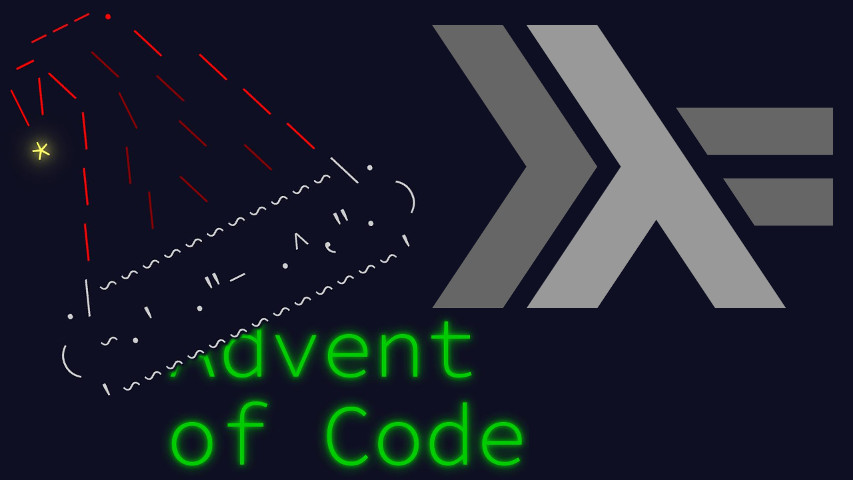Oh dear. I haven’t posted anything since last AoC. There are reasons, and it will change, but still…
Anyway.
Advent of Code is back for a new season! For its first day, “Calorie Counting”, we’re comparing elf backpack contents for calories.
Seems like a perfect opportunity to have fun with Haskell’s point-free notation again. Let’s first have a few imports to clear the floor for a literate Haskell post.
import Control.Category ((>>>))
import Data.List.Extra (sortOn,wordsBy)
import Data.Ord (Down(Down))
main :: IO ()
main = interact $Ok, we’re right in the pipeline. We’re receiving raw input here, as
in "1000\n2000\n3000\n\n4000\n…" per the example. Parsing
will start simple, let’s first split lines:
lines >>>This yields a somewhat more structured list of strings:
["1000","2000","3000","","4000",…]. Let’s group them by
paragraph, aka backpack.
wordsBy null >>>The Haskell Prelude function words splits a string into
words, cutting on spaces. The wordsBy extension generalizes
that to work on arbitrary lists. Since there’s no general way to know
what it means to be a space in a list of something that could be
non-characters, it takes an explicit function from the caller to answer
that.
Here we’re using null, which detects empty strings. More
specifically, empty lists, of which empty strings are a special
case.
So we have a list of backpacks of food items:
[["1000","2000","3000"],["4000"],…]
Let’s convert them to actual numbers we can do math on.
(map . map) read >>>That was easy. We now have
[[1000,2000,3000],[4000],…].
How many calories are in a backpack? Summing the calorie counts of the individual food items within answers that.
map sum >>>We have [6000,4000,…]. We’re really looking for the
high-calorie bags here, so let’s sort them.
sortOn Down >>>We have [24000,11000,10000,…] now.1
Now let’s get a bit of deeper point-free hackery out.
flip take >>>The take function takes two arguments: a count and a
list. It returns the first count elements of the list.
flipping it as we do here reverses the order of its
arguments: it now takes a list and a count, and returns the same result
as the unflipped variant.
We’re inserting this function in the pipeline, so it’s receiving as its first argument our sorted list of backpack calories. There’s no second argument yet, it remains a partially applied function.
So we have a function that takes a count and returns that many elements from a very specific list: the sorted calorie tallies.
flip map [1,3] >>>map takes a function and a list, and returns the list of
the results of applying said function to all elements in the input list.
flip map takes a list and a function, and returns… you get
the picture.
flip map [1,3] assigns that input list to be
[1,3], takes a function and applies.
We are transferred that function from uppipe, so we now have a list
of 2 elements: the result of taking the first 1 and 3 elements from the
sorted calorie tallies. Something like that:
[[24000],[24000,11000,10000]].
map sum >>>If you’ve made it this far, you understood this. We get
[24000,45000].
We could keep going and format it properly, but I’ll be lazy and count on our attention span to remember that list’s first element is the answer to part 1 and the second the answer to part 2.
showNo >>> at the end of the line, this is the end
of the pipeline. [24000,45000] is printed out.
This concludes this first day of AoC, with a now traditional demonstration of point-free coding. Which, as we can see, is both extremely powerful and extremely risky2 as far as long-term legibility goes.
See you tomorrow!
You have to either trust me or go see the original problem statement here, since those high-calorie backpacks weren’t visible in the truncated input.↩︎
And this year’s day 1 readability is impressive compared to last year’s↩︎



